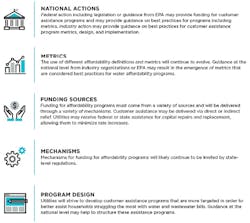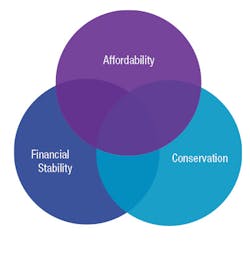The Future of Affordability Programs
In the fourth and final article in this series, we discuss how the appropriate guidance, tools, and resources can help utilities craft affordability programs that do not come at the expense of conservation and financial stability.
By Katie Cromwell, Kevin Kostiuk, and Henrietta Locklear
At a recent utility conference an exasperated utility manager said, “I know that having a customer assistance program is the right thing to do and would benefit people in my community, but I have spent the past five years trying to keep rates low while encouraging conservation through two significant droughts. I can’t help but think that giving away water is going to ruin all the hard work and progress I have made.”
=> Read Part 1: Affordability Meets Sustainability
=> Read Part 2: Affordability in Other Industries
=> Read Part 3: Affordability: Lessons Learned from Gas and Electric Utilities
The manager’s comments highlight the sometimes-competing objectives that utilities face. However, a financially sustainable utility that promotes conservation and addresses affordability is not a mythical unicorn. Given the appropriate guidance, tools, and resources, utilities can craft affordability programs that do not come at the expense of conservation and financial stability.
National Action
Affordability has been drawing greater attention in the water industry as customers all over the country experience consistent rate increases that exceed increases in the consumer price index (CPI); high-profile news stories break about customer distress in water systems with high rates of poverty; and industry organizations focus on affordability measurement and encourage revisions to EPA guidance on community affordability.
As the issue gains national prominence, one possible outcome is federal action and funding, like the energy industry experienced with the Low-Income Home Energy Assistance Program (LIHEAP). But given the differences between the two industries and the circumstances that are driving affordability concerns, other paths should be considered in the short term. Industry-driven guidance and assistance may help create best practices for utilities.
Three large industry organizations — the American Water Works Association (AWWA), Water Environment Federation (WEF), and National Association of Clean Water Agencies (NACWA) — are all focusing on affordability. AWWA and WEF recently sponsored the Transformative Issues Symposium on Affordability, which featured presentations from industry leaders on overcoming legal and regulatory barriers, affordability metrics, and communicating with difficult-to-reach customers.1 Further, AWWA has developed a draft policy statement on affordability that recommends the “adoption of policies and procedures by utilities, regulators, and local and state governments to address the affordability challenges experienced by some of their residential customers.” Along with NACWA’s national advocacy on the issue2, these examples show how industry leadership may shape the development of affordability solutions and customer assistance programs at individual utilities. State-level action may also precede or supplant national policy actions or funding.
Components of Water Affordability Programs
Growth in Number of Programs
As affordability issues increase, utilities have taken actions to mitigate these concerns for their customers. EPA’s 2016 survey of nearly 800 utilities found that more than a quarter (228 out of 795 utilities, or 28.7 percent) had one or more customer assistance offerings, such as bill discounts, flexible payment plans, or crisis assistance.3 Since that time, industry experts have seen a growth in water affordability programs nationwide. Large cities such as Philadelphia and Baltimore are addressing this issue in innovative ways. As affordability programs burgeon, critical issues such as definitions, metrics, balance of affordability with important long-term concerns, and continued flexibility to tailor programs to local circumstances will continue to be important for utilities.
Affordability Definition and Metrics Moving Forward
Historically, water utilities have coopted the “2 percent” guidance contained in the 1997 Combined Sewer Overflow Long-Term Control Plan (LTCP) and applied it to individual customer incomes to define and measure affordability. It is important to note that the “2 percent” guidance is typically applied to median household income rather than applied individual customer income. Applying the guidance to median household income is particularly problematic because it fails to address affordability for the lowest income population.
However, new definitions and standards for affordability are being developed to better assess and define affordability at the customer level. Each of these new measures have different advantages and disadvantages and there is no clear consensus on the “best” measure.
From the utility perspective, there is increasing flexibility for utilities to use the affordability measure that best reflects the characteristics of their community, the data available, and the resources of the utility. For example, a small utility with limited resources may opt for a simple, easy-to-calculate metric like percentage of poverty-level income, while a larger, more data-driven utility may use the affordability ratio, or the ratio of basic water and wastewater services to disposable household income. Looking ahead, EPA and industry associations may provide additional guidance on best practices for affordability definitions and metrics for water affordability programs.
Balancing Conservation and Financial Stability
With affordability being an increasingly hot topic in the water utility sector, it is important to remember that other considerations, such as conservation and financial stability, must still be considered. Utility managers are often being pushed and pulled in different directions, but ultimately, they have the difficult and important job of maintaining the long-term sustainability of the utility while providing high quality water service to their community.
Conservation: Households may not be able to conserve their way to affordability, especially given increasing water and wastewater rates. Even a maximally efficient home can only reduce use so far to meet basic health and sanitation needs. Just because a household uses a minimum amount of water for its needs does not mean its service is necessarily affordable. Fixed charges must still be paid, which are linked to the requirement for financial stability. Typically, 20 to 40 percent or more of a water bill is represented by fixed charges, higher still for sewer charges. Additional conservation may have little impact on reducing bills for struggling households.
Some customers have little control over their ability to conserve water. Many tenants of leased single-family and multi-family residential housing pay water and sewer bills and have less efficient fixtures and appliances. A tenant struggling with a bill most likely does not have the means or authority to replace fixtures and property owners have little incentive to replace these items when they are not paying the bill.
During the most recent statewide drought in California, Pasadena Water and Power (PWP) provided faucet aerators and low-flow shower heads free of charge.4 This was in addition to rebate programs for other indoor and outdoor efficiency upgrades. Through the installation of these upgrades, customers could reduce their water consumption and thus reduce their bill. Many customers took advantage of these offerings, including landlords who pay bills on master-metered properties and tenants on individually metered units.
Financial Stability: Agencies must choose between competing objectives to remain financially stable. Water supply constraints, water quality constraints, and system capital costs, among others, dictate the requirements of an agency to remain financially sound. For example, in a tiered rate structure, if affordability is achieved by minimizing the charge for the first several units of water, then more fixed costs are recovered in higher tiers. However, this strategy becomes problematic in times of drought and reduced consumption, potentially leading to a revenue shortfall.
Similarly, in place of designing and implementing affordability programs, many utilities use their rates and rate structure as de facto affordability programs. Rates can only do so much for affordability before running into financial and sometimes legal constraints. For example, if a water utility wishes to promote affordability by reducing the fixed charge recovered on the meter, it must do so for all customers, potentially generating revenue instability when more of the agency’s fixed costs are recovered through variable charges.
However, rate design and conservation, if done thoughtfully with a clear understanding of the financial and practical limitations, can be used to promote affordability.
Flexible Program Development
Flexibility in development of affordability programs is key to ensuring water affordability issues are effectively addressed at the local customer level. An increasing number of utilities have explored unique solutions to affordability issues in their community, including utilizing alternative affordability definitions and metrics, tiered assistance, and increased public outreach. In the absence of affordability guidance at the federal level, it is expected that utilities will continue to develop customized customer assistance programs for their community. Ideally, any federal action would allow for this flexibility to be maintained while still providing helpful guidance for utilities and allowing for comparison between utilities. WW
References
1. “AWWA and WEF launch new Symposium on Affordability,” AWWA, June 28, 2018, https://www.awwa.org/home/awwa-news-details/articleid/5058/awwa-and-wef-launch-new-symposium-on-affordability.aspx (accessed September 21, 2018).
2. “Infrastructure Funding & Affordability,” NACWA, https://www.nacwa.org/advocacy-analysis/campaigns/infrastructure-funding-affordability (accessed September 21, 2018).
3. Drinking Water and Wastewater Utility Customer Assistance Programs, U.S. EPA, April 2016. Available at: https://www.epa.gov/sites/production/files/2016-04/documents/dw-ww_utilities_cap_combined_508.pdf (accessed August 21, 2018).
4. “Water & Energy Direct Install Program (WeDIP),” Pasadena Department of Water and Power, https://ww5.cityofpasadena.net/water-and-power/wedip/ (accessed September 21, 2018).
About the Authors:
Katie Cromwell is a senior consultant with Raftelis in its Cary, N.C., office. With a background in environmental regulation, permitting and compliance as well as financial management, she has worked extensively with water, wastewater, and stormwater utilities on implementing funding strategies including the analysis and visualization of affordability within communities.
Kevin Kostiuk is a senior consultant with Raftelis in its Los Angeles, Calif., office. His background is in economics and accounting and his areas of expertise include financial accounting, environmental policy, water supply and flood control policy and operations. In addition, he has worked extensively in innovative rate design in response to emerging issues such as drought and affordability concerns.
Henrietta Locklear is a senior manager with Raftelis and leads its Memphis, Tenn., office. Her background is in local government management including environmental finance and public policy. Her work includes assessing and implementing affordability programs for large utilities. She leads the Raftelis affordability community of practice, a group of practitioners within the company engaged in leadership on affordability issues in the utility industry.
Circle No. 231 on Reader Service Card





